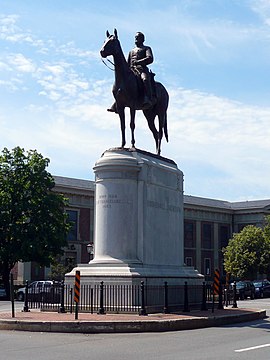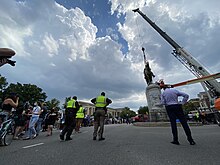
Thomas Jonathan "Stonewall" Jackson was a general officer in the Confederate States Army during the American Civil War. He played a prominent role in nearly all military engagements in the Eastern theater of the war until his death. Military historians regard him as one of the most gifted tactical commanders in U.S. history.

Ambrose Powell Hill Jr. was a Confederate general who was killed in the American Civil War. He is usually referred to as A. P. Hill to differentiate him from Confederate general Daniel Harvey Hill, who was unrelated.

Monument Avenue is a tree-lined grassy mall dividing the eastbound and westbound traffic in Richmond, Virginia, originally named for its emblematic complex of structures honoring those who fought for the Confederacy during the American Civil War. Between 1900 and 1925, Monument Avenue greatly expanded with architecturally significant houses, churches, and apartment buildings. Four of the bronze statues representing J. E. B. Stuart, Stonewall Jackson, Jefferson Davis and Matthew Fontaine Maury were removed from their memorial pedestals amidst civil unrest in July 2020. The Robert E. Lee monument was handled differently as it was owned by the Commonwealth, in contrast with the other monuments which were owned by the city. Dedicated in 1890, it was removed on September 8, 2021. All these monuments, including their pedestals, have now been removed completely from the Avenue. The last remaining statue on Monument Avenue is the Arthur Ashe Monument, memorializing the African-American tennis champion, dedicated in 1996.
Lee–Jackson–King Day was a holiday celebrated in the Commonwealth of Virginia from 1984 to 2000 as a combination of Lee–Jackson Day and Martin Luther King Jr. Day. Beginning in 2000 the state observed them as two distinct holidays.
Arthur Ashe Boulevard is a historic street in the near the West End of Richmond, Virginia, providing access to Byrd Park. It serves as the border between the Carytown/Museum District to the west and the Fan district to the east. Attempts were made to rename the street after Arthur Ashe, a tennis star and social activist who was born and grew up in Richmond, but previous attempts failed until February 2019 when Richmond City Council voted in favor of changing the name to Arthur Ashe Boulevard. Near the south end is Richmond's Boulevard Bridge across the James River. Arthur Ashe Boulevard intersects with main arteries Cary Street, Main Street, Monument Avenue, Broad Street, Leigh Street, and Interstate 64/95, and terminates at Hermitage Road. The Diamond is located on Arthur Ashe Boulevard. The intersection of Arthur Ashe Boulevard and Monument Avenue featured a statue of Stonewall Jackson.
Confederate monuments and memorials in the United States include public displays and symbols of the Confederate States of America (CSA), Confederate leaders, or Confederate soldiers of the American Civil War. Many monuments and memorials have been or will be removed under great controversy. Part of the commemoration of the American Civil War, these symbols include monuments and statues, flags, holidays and other observances, and the names of schools, roads, parks, bridges, buildings, counties, cities, lakes, dams, military bases, and other public structures. In a December 2018 special report, Smithsonian Magazine stated, "over the past ten years, taxpayers have directed at least $40 million to Confederate monuments—statues, homes, parks, museums, libraries, and cemeteries—and to Confederate heritage organizations."

Thomas Jonathan Jackson is a historic bronze equestrian statue of Confederate general Stonewall Jackson which was formerly located at Courthouse Historic District of Charlottesville, Virginia and installed in 1921. The statue was sculpted by Charles Keck and was the third of four works commissioned from members of the National Sculpture Society by philanthropist Paul Goodloe McIntire. It was the second of three statues McIntire donated to the city of Charlottesville, which he did over a period of five years from 1919 to 1924. The statue was listed on the National Register of Historic Places in 1997.

The Robert E. Lee Monument was an outdoor bronze equestrian statue of Confederate general Robert E. Lee and his horse Traveller located in Charlottesville, Virginia's Market Street Park in the Charlottesville and Albemarle County Courthouse Historic District. The statue was commissioned in 1917 and dedicated in 1924, and in 1997 was listed on the National Register of Historic Places. It was removed on July 10, 2021, and melted down in 2023.

The Robert E. Lee Monument in Richmond, Virginia, was the first installation on Monument Avenue in 1890, and would ultimately be the last monument removed from the site. Before its removal on September 8, 2021, the monument honored Confederate Civil War General Robert E. Lee, depicted on a horse atop a large marble base that stood over 60 feet (18 m) tall. Constructed in France and shipped to Virginia, it remained the largest installation on Monument Avenue for over a century; it was first listed on the National Register of Historic Places in 2007 and the Virginia Landmarks Register in 2006.

The Stonewall Jackson and Robert E. Lee Monument, often referred to simply as the Jackson and Lee Monument or Lee and Jackson Monument, was a double equestrian statue of Confederate generals Stonewall Jackson and Robert E. Lee, formerly located on the west side of the Wyman Park Dell in Charles Village in Baltimore, Maryland, alongside a forested hill, similar to the topography of Chancellorsville, Virginia, where Stonewall Jackson and Robert E. Lee met before the Battle of Chancellorsville in 1863. The statue was removed on August 16, 2017, on the order of Baltimore City Council, but the base still remains. The monument is in storage and some city council members have called for all Confederate monuments in the state to be destroyed.

More than 160 monuments and memorials to the Confederate States of America and associated figures have been removed from public spaces in the United States, all but five since 2015. Some have been removed by state and local governments; others have been torn down by protestors.

Rumors of War is a series of artworks by Kehinde Wiley examining equestrian portraiture in the canon of Western art history culminating in a bronze monumental equestrian statue by the artist of an African-American young man, created in response to the statue of Confederate General J.E.B. Stuart in Richmond, Virginia in particular and similar statues of high-ranking Confederate Army officers, some of which still stand in the United States despite persistent calls for their removal. Since the installation of Rumors of War in Richmond, all of the statues of the military leaders of the Confederacy have been removed from Monument Avenue where they had been since the first decade of the 20th century.

Richmond, Virginia, experienced a series of protests in the wake of the murder of George Floyd. Richmond was the first city in the Southeastern United States to see rioting following Floyd's murder. Richmond, formerly the capital of the short-lived Confederate States of America, saw much arson and vandalism to monuments connected with that polity, particularly along Monument Avenue.

The J. E. B. Stuart Monument is a deconstructed monument to Confederate general J. E. B. Stuart at the head of historic Monument Avenue in Richmond, Virginia, which was dedicated in 1907. Despite a majority of Virginians not supporting removal, the equestrian statue of General Stuart was removed from its pedestal and placed into storage on July 7, 2020 after having stood there for 113 years. The removal was in response to nationally reported events of police brutality and a corresponding emergency declaration in Virginia. The granite pedestal, which stood empty for nineteen months, was finally dismantled in February 2022.

The Arthur Ashe Monument is a bronze sculpture by Paul DiPasquale installed along Richmond, Virginia's Monument Avenue. The statue depicts tennis player Arthur Ashe, who was born, raised and buried in Richmond.















